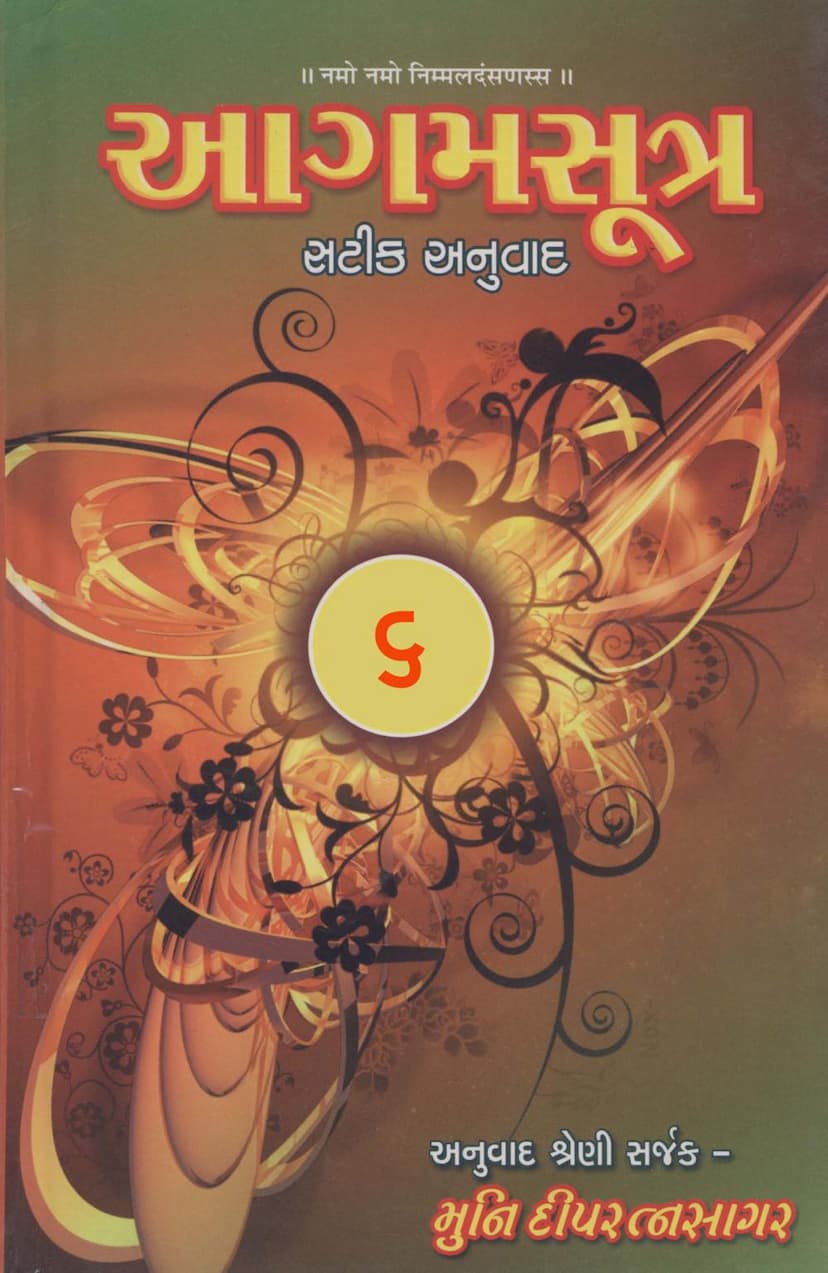Agam Satik Part 06 Sthananga Sutra Gujarati Anuwad 2
Added to library: September 1, 2025

Summary
This document is the Gujarati translation and commentary of the Sthananga Sutra, Volume 6, Part 2, of the Agam Sutra series, authored by Muni Dippratnasagar and published by Deepratnasagar. This particular volume focuses on the fourth and fifth sections (Sthan-4 and Sthan-5) of the Sthananga Sutra, following Volume 5 which covered Sections 1 through 3.
The Sthananga Sutra is the second of the eleven Angas in Jain Agamas, and its original name is Sthānāṅga, also known as Sthāna. It is divided into three parts, with this being the sixth installment in the translated series. The text notes that an independent Niryukti, Bhashya, or Churni for the Sthananga Sutra is not available, but the commentary by Shri Abhaydev Suri (Vritti/Tika) has been included in this translation.
The translation aims to be literal, with annotations and explanations provided. The text indicates that when the translation of the original Agama and its commentary include additional references, those references have been incorporated, and in some instances, grammatical nuances or specific legalistic/philosophical terms have been marked with "X - X - X".
The document then proceeds to present the content of Sthan-4, focusing on its first objective (Uddesha-1). It outlines various classifications and enumerations, often presented in sets of four or five, covering a wide range of topics relevant to Jain philosophy and practice. These include:
- Four types of end-actions (Antakriyā): Describing the outcomes for souls based on their karma and ascetic practices.
- Classifications of trees and men: Categorized into four types based on dual attributes (e.g., high in substance, high in essence; high in substance, low in essence).
- Types of language, speech, and vowels: Discussed in four categories.
- Classification of men based on qualities: Such as high/low with reference to purity, intellect, and conduct.
- The four types of intentions (Sankalp), intellect (Prajna), vision (Drishti), and conduct (Sheelachar): Categorized with varying degrees of positivity and negativity.
- Types of behavior (Vyavahar) and valor (Parakram): Analyzed in four distinct categories.
- The concept of "Kaaju" (meaning perhaps "root" or "essence") and "Riju" (meaning "straight" or "simple"): Described in relation to trees and men, and then further elaborated through various combinations of virtuousness and non-virtuousness.
- Various classifications of beings and phenomena: This includes types of trees, men, words, speech, languages, volumes, classifications of purity (Shuddhi), types of rulers, karmic classifications, states of being, sensory experiences, types of states, and classifications related to consciousness, intention, intellect, conduct, and valor.
- The four Yugas (ages): Kritayuga, Treta, Dwapara, and Kaliyuga, and their application to beings in different realms (hellish beings, humans, gods).
- The four types of purity (Shaucha): Related to body, speech, mind, and the senses.
- The four types of karma: Such as the accumulation of karma based on anger, pride, deceit, and greed.
- The four types of actions (Karma) and their consequences: Elaborated through various life forms and their karmic predisessions.
- The four types of vows (Vratas): Including those related to the senses, speech, and mind, as well as the five Mahavratas (great vows) and five Anuvratas (lesser vows).
- The concept of "Avasthiti" (existence or dwelling): Discussed in relation to the Lokas (worlds) and the nature of beings within them.
- Classifications of beings based on their actions, intentions, and dispositions: This forms a significant portion of the text, with extensive enumerations of individuals based on their virtues, vices, and states of mind, often presented in sets of four or five.
- The characteristics of celestial beings and their realms: Including descriptions of various heavens, their durations of life, and the beings residing there.
- Cosmological descriptions: Details about Jambudvipa, its mountains, rivers, and the arrangement of various continents and oceans, along with their inhabitants.
- The classification of attention (Purva) and its absence (Apurva): Discussed in relation to the actions of monks and nuns.
- The concept of "Upakrama" (means or methods): Analyzed in the context of actions related to karma.
- The nature of "Samsara" (the cycle of birth and death): Explained through various perspectives and classifications.
- The concept of "Samadhi" (meditative concentration): Discussed in the context of liberation and spiritual progress.
- The four types of knowledge (Jnana): Mati, Smriti, Abhidha, and Avadhi.
- The four types of speech (Vani): Such as pleasing, harsh, truthful, and untruthful.
- The concept of "Pratishtha" (prestige or reputation): Discussed in various contexts.
- The importance of "Swadhyaya" (self-study) and its hindrances: Outlining the practices and obstacles for spiritual aspirants.
- The role of various types of individuals in the spiritual path: Including those who aid spiritual progress and those who hinder it.
- The classifications of beings based on their spiritual progress and attainment: Describing individuals who are progressing, regressing, or have achieved liberation.
The text continues to delve into detailed classifications and enumerations related to various aspects of Jain cosmology, ethics, and spiritual practice, often reiterating the importance of the "four-fold" or "five-fold" classifications that are characteristic of the Sthananga Sutra. The document provides a systematic breakdown of these concepts, offering a comprehensive overview of the Sthananga Sutra's teachings as presented in this Gujarati translation and commentary.